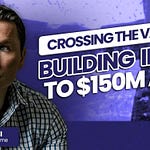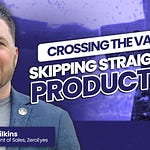Overview
Michael Grochol is a fascinating example of when a Silicon Valley-raised problem solver-come-national security expert. His approach to starting a company was long, methodical, and principled. And it led him to the helm of one of the nation’s fastest growing defense services companies.
Unlike many founders, Michael actually turned down the first opportunity he had to start a company.
Why?
He felt he wasn’t prepared.
So he focused on acquiring the skills and experiences he knew he would need, to be able to succeed when he finally stepped into the role.
Fair to say, that bet is paying off!
Michael’s Background
Growing up in Pacifica just south of San Francisco, Michael always knew that tech would be a part of his future. But the 9/11 terrorist attacks altered his trajectory. He joined the US Air Force at age 18, right after high school. He began his career flying AWACS, the Air Force airborne early warning and control surveillance aircraft, before joining Air Force Special Operations Command. Michael deployed to Iraq six times as a crew member on AC-130 gunships, and in support of the special operations community.
As he transitioned out of the military, he first worked as a contractor in support of the Defense Department and Intelligence Community. And then he had a foundational experience in a surprising place: Special Operations Command (SOCOM) Acquisition Center. His operational experience helped him better inform acquisition decisions, working with a contracting officer who showed him the ropes of how the government buys goods and services.
Preparing to be CEO
Michael shared with us his very deliberate approach to becoming a founder.
The three pillars of any business, according to Michael, are:
Growth (can you sell?)
Managing (can you deliver?), and
Enabling (business structures, processes, etc).
So after his time in service, he worked at a set of small and larger organizations to see how they operated. First was L-3 Communications, later acquired by CACI, which taught him how a mature company operates. Then he learned how to grow a business, working with a company that only had one employee on overhead, and growing it to a successful entity. Then, and only then, did he feel ready to set out on his own.
What is IronEagleX (IEX)?
Michael describes IEX as a defense tech solutions company. Their website describes them as a technology company at their core, that happens to focus on national security problems.
What that means to the team is that they are in the business of problem solving,
Sometimes that means building software.
Sometimes it means delivering qualified people.
And sometimes it requires doing both.
When they find themselves building some of the same underlying capabilities again and again, it’s a good signal that there may be an opportunity for a product. While IEX is not venture-backed, and therefore not in an ongoing hunt for Software-as-a-Service (SaaS) revenue, they are not afraid to productize key capabilities as opportunities arise.
The IronEagleX Business Model
“The secret sauce to our business is our ability to run the maze faster than everybody else.”
IronEagleX primarily delivers services. If they build something for a customer and retain some IP, they may productize it down the road, but services are the bread and butter of the 250 people and over $100M in revenue that the team has today.
One of the differentiators for the company is the realization that if software isn’t in production (that is, deployed on a customer network, being used for the mission), it doesn’t matter. So they’ve created a niche as a firm that can rapidly deploy software solutions into production in a matter of weeks, not months or years. Driven by their empathy and understanding of how the government operates, Michael and team are able to build to deploy, and work around red tape in the process.
Going to Market
IEX pursues two simultaneous go to market approaches:
Traditional Business Development: finding and responding to publicly-available acquisitions via SAM.gov
OTA / innovation approaches: Other Transaction Authority has become extremely popular in the special operations community, and allow companies to engage with the government in much more rapid, engaging fashion.
The acquisition continuum, as Michael describes it, runs from the government knowing what it wants (FAR-based contracting) to knowing they have a problem to solve, but being unsure of exactly how to solve it (OTA).
He particularly enjoys living on this OTA end of the spectrum.
How IEX Transitioned to a Major Production Contract
IEX’s largest government contract started as a prototype Other Transaction Agreement. The company met a government customer doing a whole bunch of software engineering with different teams in different places; there were seven distinct contracts for data analytics at the time, plus contracts to build an underlying platform for the analytics, and contracts for app development atop the platform.
This monstrosity of a program featured five prime contractors (defense behemoths with revenue in the billions), 10,000 active users, and a network that routinely had more than 2,000 simultaneous active users. And they operated across Unclassified, Secret, and Top Secret networks.
The customer turned to a new OTA to bring in a consolidated manager of this effort.
The government began by asking the companies to show their past performance to demonstrate their ability to accomplish the task of unifying the approach. Relevant qualifications included operating in cloud environments with similar characteristics, and application development.
This wasn’t just a paperwork exercise; the government actually brought the potential performers together to lay out the problem set, then gave them time to follow up one on one and ask clarifying questions and meet with others doing the work.
From there the process involved a white paper submission laying out a proposed approach.
Then, almost like a job interview, the government asked for a work sample test. The subset of companies that met the initial qualification were invited to come in and give an oral presentation. This involved using a representative data set and laying out exactly how the company would tackle app development and analytics on this particular type of data.
Michael and IEX put together a team that competed on this task, and on the day that Russia invaded Ukraine, IEX became one of two companies - out of 12 total - selected to perform on the prototype OT contract.
And that’s when the real fun began: IEX went head-to-head with the other firm over eight weeks, with the government observing whether they could deliver on their pitch from the oral presentation.
30 days later, IEX received word that they had won.
Their prize?
The opportunity to transition to a production contract, and to transition all the other contracts under one umbrella. This meant employing their human-centered design process to transition over 150 personnel in around six months.
Lessons from the IEX Case Study
Delivery really is a Superpower: Michael explains that often outsiders struggle to deliver capabilities on a network - or “in production.” His experiences, and his team’s repeated expertise, allows them to understand not only what a customer needs, but how they need it delivered to be able to use it.
Educate, don’t complain: Michael makes the point that while IEX enjoys success with OTA-based contracts, they cannot show up and demand them, nor do they complain when the government takes a different approach (just like you wouldn’t tell Apple the way they sell an iPhone is dumb, and expect them to change). IEX learned to play the game by the government’s rules, seeking to educate customers over time how alternative approaches like OTA could produce a better outcome.
Build for Scale: Michael and IEX built teams and processes from the beginning that were meant to scale. This is what enabled them not only to respond to the government’s data analytics request, but also to field a team that could deliver rapidly, and transition to program execution shortly thereafter. As the contract came online, they onboarded more than a dozen people in under two weeks. Access to talent and ability to scale was truly a delivery superpower.
Practice like you Play. Each year, IEX goes through a planning process called “Shutdown.” During Shutdown, IEX leadership makes quarterly plans for the next year, including goalsetting and pipeline evaluation. This ensures they won’t be caught flat-footed.
IEX is a vital part of a diverse defense tech ecosystem: It’s not all startups and behemoths! IEX occupies an interesting middle ground. They company is a modern engineering firm that can operate at decent scale, but they aren’t as large and stodgy as a traditional prime. They’re not venture-backed, and not as young and attention-grabbing as a startup, but they also have a significant track record of performance. It’s an interesting category of company that doesn’t get enough attention!
For more on IronEagleX: https://ironeaglex.com/
For more on Michael Grochol: https://www.linkedin.com/in/michael-grochol/
For more Crossing the Valley: https://www.youtube.com/@FrontdoorDefense













Ep. 09: How IronEagleX Reverse Engineered a Rapidly-Growing Defense Tech Startup